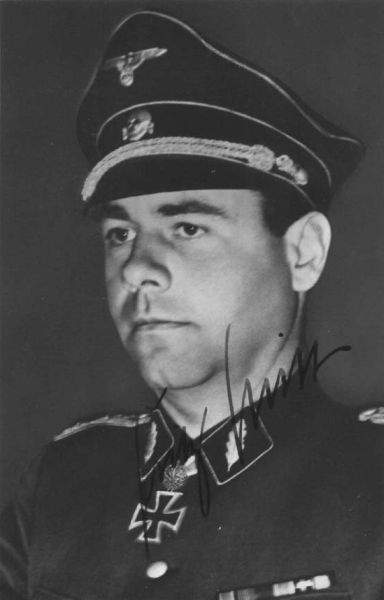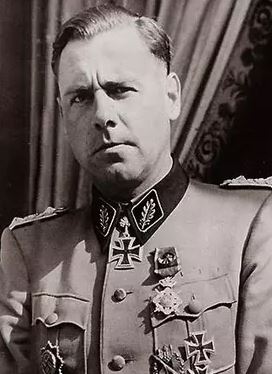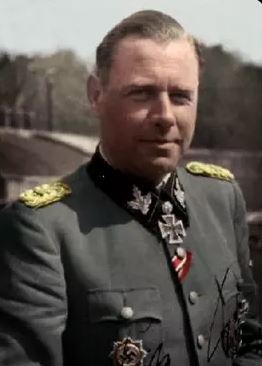Witt, Fritz (Waffen SS)
- Date of birth:
- May 25th, 1908 (Hohenlimburg/Western Phalia, Germany)
- Date of death:
- June 14th, 1944 (Caen/Normandy, France)
- Buried on:
- German War Cemetery Champigny-St.-André
Plot: 8. Row: 12. Grave: 1027. - Service number:
- SS-Nr.: 21.518 // NSDAP-Nr.: 816.769
- Nationality:
- German
Biography
Promotions:
01.10.1933: SS-Untersturmführer
09.05.1934: SS-Obersturmführer
01.06.1935: SS-Hauptsturmführer
25.05.1940: SS-Sturmbannführer
27.11.1941: SS-Obersturmbannführer
30.01.1943: SS-Standartenführer
01.07.1943: SS-Oberführer
20.04.1944: SS-Brigadeführer
Career:
01.12.1931: joined the NSDAP and the SS
17.03.1933: SS-Stabswache Berlin
00.11.1933: SS-Ustuf, 2. Sturm, LAH
00.05.1934: SS-Ostuf, Chef, 3. Sturm, SS-Standarte 'Deutschland', SS-VT
00.03.1938: SS-Hstuf, Chef, 3. Sturm, SS-Standarte 'Deutschland', SS-VT - Anschluss in Austria
00.10.1938: SS-Hstuf, Chef, 3. Sturm, SS-Standarte 'Deutschland', SS-VT - occupation of the Sudetes
00.03.1939: SS-Hstuf, Chef, 3. Sturm, SS-Standarte 'Deutschland', SS-VT - occupation of Bohemia and Moravia
01.09.1939: SS-Hstuf, Chef, 3. Sturm, SS-Standarte (mot.) 'Deutschland', SS-VD, Panzer-Verband 'Kempf' - Operation Fall Weiss, campaign in Poland
00.10.1939: SS-Hstuf, Führer, I. Bataillon, SS-Infanterie-Regiment (mot) 'Deutschland', SS-VD
00.05.1940: SS-Stubaf, Führer, I. Bataillon, SS-Infanterie-Regiment (mot) 'Deutschland', SS-VD - campaign in France
27.05.1940: SS-Stubaf, his Bataillon destroyed 9 out of 20 British Matilda tanks in close-combat without anti-tanks means
16.10.1940: SS-Stubaf, Kdr, III. Bataillon, Infanterie-Regiment (mot.) Leibstandarte SS Adolf Hitler, SS-VD
26.03.1941: SS-Stubaf, Kdr, I. Bataillon, Infanterie-Regiment (mot.) Leibstandarte SS Adolf Hitler, SS-VD - Operation Marita, Balkans and Greece
10.04.1941: SS-Stubaf, Führer, Kampfgruppe 'Witt' - Klidi Pass, south of Vevi - death of his brother Franz Witt
22.06.1941: SS-Stubaf, Kdr, I. Bataillon, SS-Infanterie-Regiment (mot.), SS-Division Leibstandarte SS Adolf Hitler, Heeresgruppe Süd - campaign in Russia, Operation Barbarossa
00.08.1941: SS-Stubaf, Kdr, I. Bataillon, SS-Infanterie-Regiment (mot.), SS-Division Leibstandarte SS Adolf Hitler, Panzer-Gruppe 1 then LIV. Armee-Korps - Kiev
17.09.1941: Crimea, Perekop, Tarter Ditch
00.11.1941: SS-Ostubaf, Kdr, I. Bataillon, SS-Infanterie-Regiment (mot.), SS-Division Leibstandarte SS Adolf Hitler, Panzer-Gruppe 1 - Rostov, Don, Mius
00.05.1942: SS-Ostubaf, recapture of Rostov on the Don River
00.06.1942: SS-Ostubaf, refit in France
00.08.1942: SS-Ostubaf, Führer, SS-Panzergrenadier-Regiment 1, 1. SS-Panzergrenadier-Division 'Leibstandarte Adolf Hitler'
00.01.1943: SS-Staf, Kdr, SS-Panzergrenadier-Regiment 1, 1. SS-Panzergrenadier-Division 'Leibstandarte Adolf Hitler', SS-Panzer-Korps - Kharkov
08.02.1943-09.02.1943: fightings at Merefa
02.03.1943-16.03.1943: recapture of Kharkov : fightings in Dergatschi
00.06.1943: SS-Staf, Führer, 12. SS-Panzergrenadier-Division "Hitlerjugend"
01.07.1943: SS-Ofu, Kdr, 12. SS-Panzergrenadier-Division "Hitlerjugend", Beverloo, Belgium
00.04.1944: SS-Brif, Kdr, 12. SS-Panzergrenadier-Division "Hitlerjugend", Panzergruppe West, Caen, Normandy
02.06.1944: his divsion is declared ready for combat
06.06.1944: fightings near Evrecy then Carpiquet Aerodrome
07.06.1944: fightings in Authie and Buron
08.06.1944: fightings in Norrey-en-Bessin, HQ at Venoix
14.06.1944: KIA when a British naval barrage hit his divisional command post in Venoix
Do you have more information about this person? Inform us!
- Period:
- Second World War (1939-1945)
- Rank:
- SS-Hauptsturmführer (Captain)
- Unit:
- Chef, 3. Sturm, SS-Standarte 'Deutschland', SS-VT
- Awarded on:
- September 19th, 1939
- Period:
- Second World War (1939-1945)
- Rank:
- SS-Hauptsturmführer (Captain)
- Unit:
- Chef, 3. Sturm, SS-Standarte 'Deutschland', SS-VT
- Awarded on:
- September 25th, 1939
- Period:
- Second World War (1939-1945)
- Rank:
- SS-Sturmbannführer (Major)
- Unit:
- Kommandeur, I. Bataillon, SS-Infanterie-Regiment „Deutschland“, SS-Verfügungs-Division
- Awarded on:
- September 4th, 1940
"On the 27.05.1940 the Standarte was advancing in column formation alongside the 3. Panzer-Division, which was itself advancing towards Bailleul (in Flanders) by way of Merville. The Standarte crossed the Lys river following heavy fighting with strong English motorized units.
On the evening of this day the I. Bataillon of SS 'Deutschland' was deployed along the right wing, with its neighbour trailing far behind. During this time it came under attack by 20 English tanks (with infantry following behind) from the direction of Estaires. At least 10 of these tanks penetrated into the positions of the Bataillon, which had no anti-tank weapons on hand at the time due to there being no available bridges.
However the Bataillon resisted fanatically with its entire infantry contingent together with all light and heavy infantry weapons, and its combined fire prevented the English from breaking through its positions. 9 enemy tanks were rendered immobile before the frontline of the Bataillon.
In all this time the Bataillon commander provided a model of fearlessness and will to resist for his men, who prosecuted the battle against the enemy tanks with great energy as they defended from water ditches, hedges, craters and basements. Their commander was the soul of the resistance.
Later on the Bataillon would once again repulse a major enemy breakthrough attempt near Arthonnay (located on the Langres Plateau) on the 17.06.1940. On the previous night it had defeated the attacking French forces over the course of a multi-hour battle (fought partially in close combat), thereby laying the groundwork for the Regiment's overwhelming success on the followng day that saw almost 20000 prisoners being taken. In this engagement the Bataillon commander once again directed the defence from the foremost line, and his actions were decisive for bringing about the collapse of this futile enemy breakthrough attempt.
In this war his Bataillon has consistently fought with distinction during its period of service in the western theatre of operations.
During the battles on Zeeland the unit was the first to force a crossing over the Bevelund Canal (which was toughly defended by numerically superior French forces), afterwards thrusting deep into the hostile position despite the presence of ongoing French resistance on both sides of the breakthrough point. In this battle the Bataillon captured about 1000 prisoners.
SS-Sturmbannführer Witt has previously distinguished himself in the Polish campaign. Here he led his Kompanie with great prudence and bravery, and he therefore became one of the first of the Standarte to receive the Iron Class Second Class. He would later become the first member of Panzer-Division Kempf to receive the Iron Cross First Class on account of an assault operation that he personally led in the area before Modlin. He received this award from the hands of Generalmajor Kempf himself."
199th Award.
- Period:
- Second World War (1939-1945)
- Rank:
- SS-Sturmbannführer (Major)
- Awarded on:
- 1941
- Period:
- Second World War (1939-1945)
- Awarded on:
- June 23rd, 1941
- Period:
- Second World War (1939-1945)
- Awarded on:
- June 23rd, 1941
- Period:
- Second World War (1939-1945)
- Rank:
- SS-Obersturmbannführer (Lieutenant-colonel)
- Unit:
- Kdr, I. Bataillon, SS-Infanterie-Regiment (mot.), SS-Division "Leibstandarte Adolf Hitler"
- Awarded on:
- February 8th, 1942
Award 64/2.
- Period:
- Second World War (1939-1945)
- Rank:
- SS-Obersturmbannführer (Lieutenant-colonel)
- Unit:
- Kdr, I. Bataillon, SS-Infanterie-Regiment (mot.), SS-Division "Leibstandarte Adolf Hitler"
- Awarded on:
- July 16th, 1942
- Period:
- Second World War (1939-1945)
- Rank:
- SS-Obersturmbannführer (Lieutenant-colonel)
- Unit:
- Kdr, I. Bataillon, SS-Infanterie-Regiment (mot.), SS-Division "Leibstandarte Adolf Hitler"
- Awarded on:
- July 1942
- Period:
- Second World War (1939-1945)
- Rank:
- SS-Obersturmbannführer (Lieutenant-colonel)
- Awarded on:
- September 4th, 1942
- Period:
- Second World War (1939-1945)
- Rank:
- SS-Standartenführer (Colonel)
- Unit:
- Kommandeur, SS-Panzer-Grenadier-Regiment 1, „Leibstandarte SS Adolf Hitler“, Heeresgruppe Süd
- Awarded on:
- March 1st, 1943
"I am recommending the commander of the 1. Panzer-Grenadier-Regiment of the Leibstandarte SS Adolf Hitler, SS-Standartenführer Fritz Witt, for the award of the Oakleaves to the Knight's Cross of the Iron Cross.
Justification:
1.) Klidi-Pass:
Following the Standarte's thrust through southern Yugoslavia and its crossing of the Greek border at Florina, the unit received the mission of opening up the heavily defended Klidi Pass in order to facilitate a continued advance by friendly Panzer units towards the south.
In the ensuing operation the then commander of the I. Bataillon, SS-Standartenführer Witt, would demonstrate a courageous devotion to duty. During this time he personally reconnoitred the assembly area for his Bataillon under the most difficult of circumstances, and after his men were inserted into the foremost line he himself prosecuted the attack until his troops had crushed the bitterly defending English forces following several hours of ferocious combat. The enemy lost numerous dead and significant quantities of war materiel.
This success is attributable to the outstandingly brave example of the commander (which never failed to inspire his men to act likewise), and the result was that the way was opened for the victorious advance into the heart of Greece. SS-Standartenführer Witt thereby made a major contribution towards the later successes in the campaign against Greece.
2. Capture of Novo Arkhangelsk:
On the 01.08.1941 SS-Standartenführer Witt received a written order from General Kempf to attack Novo Arkhangelsk and take firm control of this key position. Witt thus attacked the numerically superior defending foe immediately after his Bataillon had assembled for battle. The enemy was ejected after several hours of bitter close combat, and Novo Arkhangelsk fell into our hands. Although the enemy launched very fierce counterattacks in response they were unable to recapture what they had lost. With this success a major step towards the closing of the developing encirclement here was achieved.
SS-Standartenführer Witt distinguished himself in this battle through his superior leadership and personal bravery.
3. Crossing of the Mius:
In order to prevent a continued pursuit of those Soviet forces that had been smashed near Mariupol, the enemy tried to create a strong bridgehead position across the Mius river to the west of Taganrog. However, despite the strongest of hostile resistance from strongly fortified positions along the eastern bank of the Mius, the commander [Witt] succeeded in forcing a crossing over the Mius with initially weak forces. Although they launched strong counterattacks in response, the enemy proved unable to eliminate this bridgehead.
With this act SS-Standartenführer Witt enabled the resumption of the pursuit battle in this region, which would lead to the capture of Taganrog on the 17.10.1941.
4.) Rostov:
Extraordinarily bad weather conditions resulted in the friendly attack on Rostov grinding to a halt, and the III. Panzer-Korps went over to the defense. In this situation SS-Standartenführer Witt would secure favourable preconditions for the later attack against Rostov through his meticulously employed reconnaissance.
When this attack began on the 17.11.1941, it was Witt who once again led his Bataillon's spearhead forwards against the fiercest of enemy resistance. Then, after Rostov itself had been reached on the 20.11.1941, he fought at the head of his badly depleted Bataillon as it pushed forward to the Don river in heavy urban combat. He and his handful of men eliminated strong enemy columns.
The apex of this great success (made all the more impressive due to the enemy's great numbers) came when his 3. Kompanie succeeded in creating a bridgehead over the Don river on the same day.
5.) Defensive Battle East of Kharkov:
Witt and his Regiment achieved outstanding feats during the defensive battle at Tschugujew (east of Kharkov). Here his Kompanien and Bataillone were immediately thrown into the fight after detraining at their station. The Regiment (which only had weak forces on hand initially) was only able to successfully hold its assigned defensive sector of 32 km against much greater opposing numbers thanks to the skillful leadership and ruthless devotion to duty displayed by its commander. By the end of this battle the Regiment only had 2 operational Bataillonen available.
Counterthrusts launched from this defensive position inflicted bloody losses on the foe, and also destroyed those enemy forces that breached the frontline.
6.) Merefa:
Kampfgruppe Witt thrust forward from the area east of Merefa in order to guard the left flank of the reinforced SS-Rgt. 'Der Führer', which was itself operating in the northern flank of the Russian 6th Guards Cavalry Corps. Witt and his Kampfgruppe met with good success on the very first day of action, destroying 3 tanks and 2 armoured cars during the course of the attack against Taranowka. Russian losses in dead during this attack amounted to 600. The end result was that the strongly occupied enemy positions at Taranowka were cleared of the foe, and the Soviets were thrown back as far as the northern part of Bereka.
Together with the Division's Aufklärungs-Abteilung (which thrust eastwards from the Jefremowka area), SS-Standartenführer Witt had heavily threatened the rear of the 6th Russian Guards Cavalry Corps via this thrust against Bereka. He thus had an important share in the eventual destruction of this formation.
On the 20.02.1943 the Russians attempted to smash through the defensive front of the 1. Regiment of the LSSAH. Their goal was to break into the rear of the Armee's northern wing by capturing Nowaja Wodolaga. However this attempt failed due to the efforts of SS-Standartenführer Witt, who was able to bloodily repulse all enemy attacks (some of which had tank support) that were launched against his thinly held defensive sector of 20 km.
When the enemy succeeded in forcing their way into the friendly strongpoint at Bulachi Farm (located east of Nowaja Wodolaga), Witt personally gathered up his Regiment's last reserve forces and led them into a counterthrust. Those enemy forces that had broken into the strongpoint (namely strong elements of all 3 regiments from the 1st Russian Cavalry Division) were completely destroyed.
Witt has proven himself in all his engagements due to a combination of skillful leadership of his Regiment and exceptional bravery before the enemy. He is worthy of being awarded the Oakleaves to the Knight's Cross of the Iron Cross."
200th Award.
Sources
- Photo 1:
- Photo 2:
- Photo 3:
- Photo: STIWOT via ANd
- - MOONEY, PETER, Waffen-SS Knights and their Battles, Schiffer Pub Ltd, 2008.
- MOONEY, PETER, Waffen-SS Knights and their Battles, Schiffer Publishing, Ltd, 2010.
- witt fritz2.JPG.
- witt fritz3.JPG.
- witt fritz4.JPG.
- Royal Decree No. 2020/16 July 1942, Romania
- Kwasny A., Kwasny G., Die Eichenlaubträger 1940-1945 (CD), Deutsches Wehrkundearchiv, Lage-Waddenhausen, 2001
- Butler R., SS-Hitlerjugend, Historia 12, Dywizji Pancernej SS, Oskar, Warszawa 2003
- Fellgiebel W.P., Elite of the Third Reich, The recipients of the Knight's Cross of the Iron Cross 1939-1945: A Reference, Helion & Company Limited, Solihull, 2003, ISBN 1-874622-46-9
- Patzwall K., Scherzer V., Das Deutsche Kreuz 1941-1945, Geschichte und Inhaber Band II, Verlag Klaus D. Patzwall, Norderstedt, 2001
- 12. SS-Panzerdivision "Hitlerjugend"
- Axis History Biographical Research via Axis History Forum
- Microfilm Publication A3343. US National Archives

























